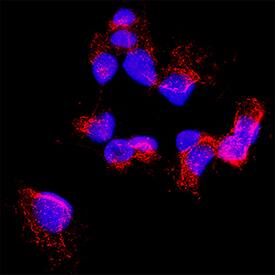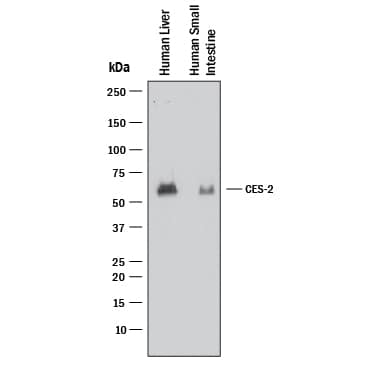Human Carboxylesterase 2/CES2 Antibody
R&D Systems, part of Bio-Techne | Catalog # MAB56571

Key Product Details
Species Reactivity
Applications
Label
Antibody Source
Product Specifications
Immunogen
Gln27-Leu559
Accession # O00748
Specificity
Clonality
Host
Isotype
Scientific Data Images for Human Carboxylesterase 2/CES2 Antibody
Detection of Human Carboxylesterase 2/CES2 by Western Blot.
Western blot shows lysates of human liver tissue and human small intestine tissue. PVDF membrane was probed with 2 µg/mL of Mouse Anti-Human Carboxylesterase 2/CES2 Monoclonal Antibody (Catalog # MAB56571) followed by HRP-conjugated Anti-Mouse IgG Secondary Antibody (HAF018). A specific band was detected for Carboxylesterase 2/CES2 at approximately 64 kDa (as indicated). This experiment was conducted under reducing conditions and using Immunoblot Buffer Group 1.Carboxylesterase 2/CES2 in A431 Human Cell Line.
Carboxylesterase 2/CES2 was detected in immersion fixed A431 human epithelial carcinoma cell line using Mouse Anti-Human Carboxylesterase 2/CES2 Monoclonal Antibody (Catalog # MAB56571) at 8 µg/mL for 3 hours at room temperature. Cells were stained using the NorthernLights™ 557-conjugated Anti-Mouse IgG Secondary Antibody (red; NL007) and counterstained with DAPI (blue). Specific staining was localized to cytoplasm. Staining was performed using our Fluorescent ICC Staining of Cells on Coverslips Protocol.Applications for Human Carboxylesterase 2/CES2 Antibody
Immunocytochemistry
Sample: Immersion fixed A431 human epithelial carcinoma cell line
Western Blot
Sample: Human liver tissue and Human small intestine tissue
Formulation, Preparation, and Storage
Purification
Reconstitution
Formulation
Shipping
Stability & Storage
- 12 months from date of receipt, -20 to -70 °C as supplied.
- 1 month, 2 to 8 °C under sterile conditions after reconstitution.
- 6 months, -20 to -70 °C under sterile conditions after reconstitution.
Background: Carboxylesterase 2/CES2
Carboxylesterase 2 is a member of a serine esterase family composed of enzymes which hydrolyze ester and amide bonds (1, 2). The members in this family share the serine hydrolase fold observed in other esterases (3). They have broad substrate specificity from small molecule esters such as phenylester to long-chain fatty acid esters and thioesters. They play a major role in the pharmacokinetics of most therapeutic agents containing an ester. By de-esterification, they can activate or inactivate the agents. They also participate in the detoxification of drugs such as cocaine and heroin in serum and liver. In addition to narcotics, they can also detoxify organophosphate and carbamate analogues used in agrochemicals or chemical nerve agents, such as malathion, sarin, tabun, and VX. In addition to the hydrolytic activity, they can perform transesterification. This reaction is important for cholesterol homeostasis. Three major human CESs have been identified (4). CES1 is highly expressed in liver. CES2 is present in the small intestine, colon, kidney, liver, heart, brain, and testis. CES3 is brain-specific. Carboxylesterase deficiency may be associated with non-Hodgkin lymphoma or B-cell lymphocytic leukemia.
References
- Redinbo, M. R. and P.M. Potter. (2005) Drug Discovery Today, 10:313.
- Satoh, T. and M. Hosokawa. (2006) Chem.-Biol. Interactions, 162:195.
- Fleming, C. D. et al. (2007) Biochemistry 46:5603.
- Imai, T. (2006) Drug Metab. Pharmacokinet. 21:173.
Alternate Names
Gene Symbol
UniProt
Additional Carboxylesterase 2/CES2 Products
Product Documents for Human Carboxylesterase 2/CES2 Antibody
Product Specific Notices for Human Carboxylesterase 2/CES2 Antibody
For research use only

